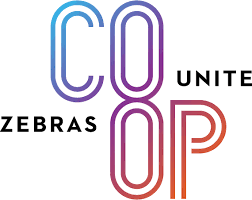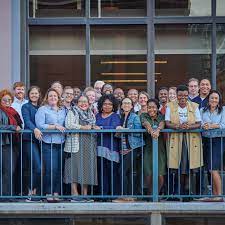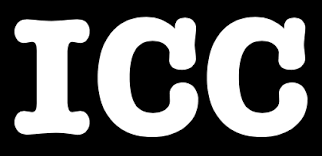
Zebras, Unite!
This is the second in a series of blog posts I will be doing this fall on the organizations featured in the book I’m writing, Connecting the Dots. All are building support for radical change that crosses ideological, issue, and other silos. Last week I wrote about Stranger’s Guide.
I’m the only person I know who lost weight while working from home during the pandemic.
 No, it isn’t because I found some magical connection between stress and appetite suppression. Rather, I finally took my doctor’s advice and started getting regular exercise by walking from our house to our grandklds’ every day so that we could first help them navigate virtual elementary school and now walk them to the building with the resumption of in-person classes.
No, it isn’t because I found some magical connection between stress and appetite suppression. Rather, I finally took my doctor’s advice and started getting regular exercise by walking from our house to our grandklds’ every day so that we could first help them navigate virtual elementary school and now walk them to the building with the resumption of in-person classes.
To keep myself from becoming hopelessly bored while I plodded around the neighborhood, I took some non-medical advice and started listening to podcasts.
Early in my podcast-listening-while-walking life, I discovered Manoush Zomorodi’s Zig-Zag. One spring day in 2020, I stopped dead in my tracks as Zomorodi began an interview with Jenn Brandel and Mara Zepeda. They were two of the cofounders of something I’d never heard of–Zebras Unite—and Zomorodi or they had entitled the episode.
“an alternative to Silicon Valley’s unicorn buillsh*t.” I continued to listen and walk, my grin undoubtedly convincing my fellow walkers that I was utterly mad.
After I got to my grandkids’ house, I immediately reached out to the Zebras.
Zebras Fix What Unicorns Break
 The Zebras themselves may have been new, but Jenn and Mara were already on my radar screen because of their earlier professional lives. Jenn had founded Hearken whose first incarnation redirected reporters toward covering solutions rather than problems so that they could avoid the “if it bleeds, it leads” ethos of contemporary journalism. Mara had founded Switchboard, which Oberlin had used to help alumni fundraisers like me keep track of our contacts and has since merged with Hearken so that both of them could focus on becoming zebras.
The Zebras themselves may have been new, but Jenn and Mara were already on my radar screen because of their earlier professional lives. Jenn had founded Hearken whose first incarnation redirected reporters toward covering solutions rather than problems so that they could avoid the “if it bleeds, it leads” ethos of contemporary journalism. Mara had founded Switchboard, which Oberlin had used to help alumni fundraisers like me keep track of our contacts and has since merged with Hearken so that both of them could focus on becoming zebras.
At first, I was surprised to hear about their frustrations with Silicon Valley, since their businesses represented the best of what the marriage of technology and business had to offer. However, unbeknownst to me, their anger and frustration with male-dominated startup culture had been mounting in part because financial system and rest of the corporate world make it hard for young, hip women like themselves to launch a business. Even more importantly, the vaunted unicorns weren’t doing much to solve America’s many problems which I had been studying for years, were filling my brain with my new addiction to podcasts, and, of course, made my whole daily walking routine possible in the first place.
But, like every group I’ll focus on in the book I’m writing, Connecting the Dots, they had crossed a mental tipping point before they went on Manoush’s show. They had (mostly) stopped complaining about what was wrong and started (mostly) doing something constructive to fix things.
They and their two other co-founders had begun finding ways of defining alternatives in which it would be easier for women and BIPOC founders to start businesses, succeed, and reshape American society while they were doing so. You can see why I stopped dead in my tracks and smiled uncontrollably after I resumed my walk.
I also quickly learned that they seemed to be having a lot of fun while they were transforming the economy. That started with their name. They decided to stay in the equine family, though, unlike unicorns, zebras actually exist. Moreover, zebras survive by forming dazzles (I kid you not) which protect their members from marauding lions and tigers because their stripes trick their predators into thinking that they are facing one single large animal who would be hard to kill.
The human Zebras started their irreverent journey by entitling their first two manifestos, Sex and Startups and Zebras Fix What Unicorns Break.
In the first one, they referred to themselves as the doulas who were helping give birth to a new economy. The second manifesto laid out the economic challenge of our times more clearly than anything I’ve seen in my half century working for social change.
A year ago we wrote “Sex and Startups.” The premise was this: The current technology and venture capital structure is broken. It rewards quantity over quality, consumption over creation, quick exits over sustainable growth, and shareholder profit over shared prosperity. It chases after “unicorn” companies bent on “disruption” rather than supporting businesses that repair, cultivate, and connect. After publishing the essay, we heard from hundreds of founders, investors, and advocates who agreed: “We cannot win at this game.”
This is an urgent problem. For in this game, far more than money is at stake. When VC firms prize time on site over truth, a lucky few may profit, but civil society suffers. When shareholder return trumps collective well-being, democracy itself is threatened. The reality is that business models breed behavior, and at scale, that behavior can lead to far-reaching, sometimes destructive outcomes.
Their radical tone aside, the Zebras are not following the same path as the democratic socialists who were elected to Congress in 2018. The founding doulas assumed that we could and should work within the capitalist system by creating and nurturing sustainable companies that filled a whole variety of unmet social needs. They knew from their own experience as founders of startups that you can make a profit AND still do your part in saving the world.
For the rest of the 2010s. they experimented with new ideas and new models. For instance, instead of creating a company so that they could sell it as soon as possible and make a pile of money for the founders and investors, the Zebras explored how one could exit to community or turn the control of and benefits form the startup to all of its stakeholders. They also reinvigorated some venerable historical ideas like the use of coops and showed how some new ones, most notably systems analysis, could shape their work. They even began to unearth kindred souls in the investment community.
The doulas started trying to grow the dazzle. Mara and Jenn stepped back from the companies they had founded. Their cofounders began thinking seriously about other issues, including access to startup capital, forging links with other related initiatives, and starting Zebra chapters around the world which totaled 18 by the end of August 2021.
Mostly, they discovered that they had to start small and grow responsibly. Companies had to remain tied to the physical or virtual communities from which they sprang. They realized, too, that a successful zebra had to be brave and take risks, and that it was easier to do so when the economic innovators supported each other just like real zebras do when they gather in their dazzles. Like everyone else I will cover in my book, they understood that zebras had to constantly change their own stripes (pun intended) by become increasingly self aware.
Or, as they put it:
“Zebras” has become a shorthand for aspiring entrepreneurs, investors, media, and adjacent communities as the expression and signal of a forward-thinking, long-game economy and business culture where ambitious companies build the goods and services we need for the society we want. Together we are creating an emergent, grassroots movement to create a pluralistic approach to business processes and development.
A Four Legged Zebra
When I started attending Zebras events in late 2020 they were figuring out how to turn what had been strong but diffuse support into something more focused and effective. Sometimes, it was not easy to see where they were heading, but they have come to focus on three of the zebra’s legs and clearly envision a fourth that people like me can help out with.
 The Coop. Even though I will focus on what it does in the United States, not all Zebras are American. Far from it. Of its first eighteen local dazzles, fifteen are based elsewhere.
The Coop. Even though I will focus on what it does in the United States, not all Zebras are American. Far from it. Of its first eighteen local dazzles, fifteen are based elsewhere.
However, as the organization evolved in the months after I get to know them, its leaders came to focus on what was happening here, especially after George Floyd’s murder. Among other things, that led to the decision to create what is likely to be the Zebras’ most visible “leg”—the coop.
However frustrated they may be with what the unicorns, it is matched by their qualms about the nonprofit and philanthropic sector where, of course, I’ve spent the bulk of my career. Whether I like to admit it or not, we do tend to move too slowly and often fail to use well defined metrics of success or failure in determining what we do.
 As a result, the Zebras cast about looking for alternative models that could somehow combine the focus profit and loss statements provide with the social commitments that are more typical of the world I come out of. They ended up with the coop.
As a result, the Zebras cast about looking for alternative models that could somehow combine the focus profit and loss statements provide with the social commitments that are more typical of the world I come out of. They ended up with the coop.
After about a year of experimenting with founders who typically traded sweat equity for membership, Zebras Unite began systematically enrolling new members in June 2021. Literally anyone is welcome, although their focus is on recruiting founders of startups that reflect the Zebras’ values regarding economic justice and social change. The coop reached nearly 150 members after its enrollment period in June and expects to top 200 after this one ends in October.
Potentially new members start by attending an information session with the Zebras’ membership coordinator, Sassy Sassoon, who has been a coop member since her parents dragged her to their local food coop when she was three.
The first session amounts to the social change equivalent of a first date. If everything clicks and both sides want to “go out” again, the potential Zebra files some basic paperwork, buys a share in the coop for $100, and then pays an annual membership fee which is determined by a sliding scale that reflects the member organizations size and income.
From then on in, the coop members define exactly what the coop does and the benefits it provides its members. Coop members can swap services with each other barter style. They can also make purchases from each other at a discount and buy products from outside vendors (e.g., software) that the coop as a whole makes available.
In that sense, the coop is seeking to create a global marketplace for like minded enterprises to do business with each other. At least in these early days, one of the key benefits of belonging to the coop will be the access it provides to often hard-to-find investment capital in ways I will describe in the next section which described the second leg of the united zebra.
As the business grows, member-owners (but not institutional investors like myself) will receive annual dividends from the coop’s profits. As is also the case with all coops, they will govern the coop itself through annual meetings and other consultations.
This month, the coop is enrolling its second batch of new members who run businesses in just about every sector and, in part because of the Inclusive Capital Collective to be discussed below, a large number of them are BIPOC or women owned. The vast majority of them are located in the United States, which stands in sharp contrast with the local chapters which are overwhelmingly based in other countries which suggests that the global Zebra movement will (and should) evolve in different ways given differeing local conditions.
The coop also has a small number of institutional investors of whom I am one. We own non-voting shares and supply the coop with what amounts to working capital which it can use for any purposes including making investments.
 The Inclusive Capital Collective. The Zebras have an ambiguous relationship with capitalism. Yes, they want to avoid the excesses of what critics refer to as neo-liberalism and the inequalities and other problems it brings in its wake. At the same time, like the other dot connectors, they are convinced that the system can be changed dramatically, if slowly, from within.
The Inclusive Capital Collective. The Zebras have an ambiguous relationship with capitalism. Yes, they want to avoid the excesses of what critics refer to as neo-liberalism and the inequalities and other problems it brings in its wake. At the same time, like the other dot connectors, they are convinced that the system can be changed dramatically, if slowly, from within.
Central here is their decision to create the Inclusive Capital Collective which the Zebras Unite Coop incubates. As will be typical of its projects, the Zebras did not launch the capital collective on its own. It has grown into a network of independent investors and sponsors communities who are committed to shifting the way not just the doulas but women and people of color, and members of other underserved communities access startup and other investment funds.
They started by building a broader team that envisioned what a zebra-like investment ecosystem would be like in three broad ways. None of them are unique to the Zebras. In fact, each of them commonly found in the literature on the need for sweeping economic reform given the priority given to companies who seek to become unicorns.
They started by rejecting the very idea that so-called shareholder value was the only return on investment that matters—a goal that has been enshrined in corporate American since Milton Friedman wrote an (in)famous article to that effect in the New York Times Magazine. As is now commonplace in the management literature, the Zebras wanted capital to benefit all of a company stakeholders, including its workers, neighbors, suppliers, and even its competitors along with whoever it was who happened to own shares in it at the moment.
Then, instead of seeking that rapid return on investment before selling the company or going public or both, Zebras talk about the need for patient capital. Conventional venture capitalists seek out unicorns in part because so few of the companies that they invest in ever turn a profit. What if, the Zebras asked, investors held on to their investments and gave them time to grow, sought a more conventional rate of return of, perhaps, seven percent in which the investment would double in value in a decade, and just more generally took their time.
That, in turn, led them to value what they refer to as exit to community. Many venture capitalists and the founders they invest in have little interest in building a company that serves all of its stakeholders for years to come. Instead, they look forward to selling the company as soon as it turns a profit and reaches a huge hoped-for market value, like the billion-dollar level usually associated with the unicorns. No one is asking founders to stay with their companies forever; after all, doulas Brandel and Zepeda came to the Zebras after walking away from enterprises they had created. Rather, they began talking about exit to community instead in which the outgoing founders and other owners would consider selling control of the business to individuals and organizations that were already part of its ecosystem, often in the very communities they served.
Again, what makes the Zebras different is that they and their partners set out to create a fund that would invest in precisely these ways. They knew full well that it would not and could not quickly come to rival the well known funds headquartered either on Wall Street or in Silicon Valley. Still, they figured that they could gradually build funds from the same kinds of people who put funds into the coop itself, albeit in this case individuals and institutions that had more than the $10,000 that it took for me to become an institutional investor in the Zebra’s first leg in ways that also make sense to corporate investors.
In time, the Collective will become a full service provider of investment funds for underserved communities world wide. For now, it is primarily funding women and BIPOC owned companies in the United States with an early emphasis on real estate. How can we increase the number of people of color who own their own homes and profitable businesses? How can we redesign the way we design our communities so that the people who actually live in them determine what they will look like? How can we use the capitalist system to truly empower people and overcome centuries of institutionalized racism and sexism?
The Consulting Firm. Zebrasunite.org is, perhaps, the least exciting of the three legs. Its role is to do the research and provide the training needed by members of the coop and the capital collective. It exists as a .org in large part because of the vagaries of section 501(c)3 of the United States Internal Revenue Service code which gives certain organizations tax-exempt status.
It thus started out as a vehicle through which charitable foundations could donate money to the Zebras for educational purposes. Thus, it funded the basic research that led to the exit to community report and related initiative which I mentioned in the preceding section. It has morphed into what amounts to a kind of consulting service in which Zebras (including coop members) help non-Zebra clients become more Zebra-like.
Clients include some of the biggest names in philanthropy, including Omidyar, Gates, Ewing and Marion Kaufman, Surdna, Wells Fargo, and Bloomberg. But as those last two names suggest, some of the big names are turning to the Zebras for help in making their own operations more zebra-like especially when it comes to social justice issues.
Whenever possible, the doulas have passed that work on to members of the coop and others in the Zebra ecosystem. As the organization evolves, the .org will take on more of the responsibility for training new coop members and offering similar services to other organizations that for whatever reason cannot join the coop but want to be trained in Zebra-like values.
The Zebras Movement. The first words you see on the Zebras landing page are:
A founder-led, cooperatively owned movement creating the culture, capital, and community for the next economy.
Given the pressures of creating the coop and the capital collective, the movement side of the Zebras world has not gotten that much attention so far.
That is also largely where I will come in and (perhaps) why one of them referred to me as “the fairy godfather we didn’t know we needed” when my family decided to become institutional investors in the coop.
It is also where the intersectional reality and, even more, potential of the Zebras come into play. By building formal and informal alliances with organizations who focus on other silos, they are at the early stages of building a much larger and potentially powerful movement for social as well as economic change.
At this point in the narrative, that’s easiest to see in the ways that the peacebuilding community can help the Zebras and how they together, in turn, are beginning to make contributions that have an impact on the issues to be considered in subsequent chapters.
With a few exceptions, coops have seen themselves as part of larger movements. That was certainly true of the coop dorms of my undergraduate days when they served as the hub of Oberlin’s counterculture and radical politics. To some degree that was true of producer coops like Ocean Spray or Land O’Lakes in their early days before they morphed into what look to most outsiders like conventional businesses.
The Zebras are also beginning to work more closely with social change movements that are not focused on business, such as the Alliance for Peacebuilding (AfP) where I spend the bulk of my time. They are in discussions with Stranger’s Guide, which I wrote about last week, and will be part of a workshop at the Build Peace conference which I’ll focus on next.
As that happens, Zebra values our beginning to infuse our work. That starts with the basics—including economic transformation in our list of goals. This should not have been an earthshattering discovery, since AfP members and others had included economic transformation in projects around the world from Israel and Palestine to Indonesia and Ibadan. Doing so in the United States was, in fact, a major step forward especially for my colleagues whose background lay primarily in mediation rather than in holistic peacebuilding.
The impact has gone beyond economics and the direct influence of the Zebras. More and more peacebuilders are adopting theories of change that incorporate entrepreneurial values such as impact investing. Some of our younger colleagues are even considering getting an MBA rather than a graduate degree in peace and conflict studies.
Meanwhile, we in the peacebuilding movement are becoming an integral part of their evolution, as is the case with organizations interested, say, in racial justice whom I’ll be profiling in October and November. Although many Zebras intuitively understood what peacebuilding is about, few of them had explicitly thought about incorporating it into their work even though conflict was going to be an unavoidable byproduct of many of their initiatives. So, we began incorporating themes like trauma healing and reconciliation into the projects taken on both by individual Zebra coop members and with the more active local chapters. Together, too, we have begun to match make, nudging peacebuilders and Zebras who happened to find themselves in the same community to work with each other.
The views and opinions expressed in this article are those of the author and do not necessarily reflect the official policy or position of the Alliance for Peacebuilding or its members.
Also published on Medium.
